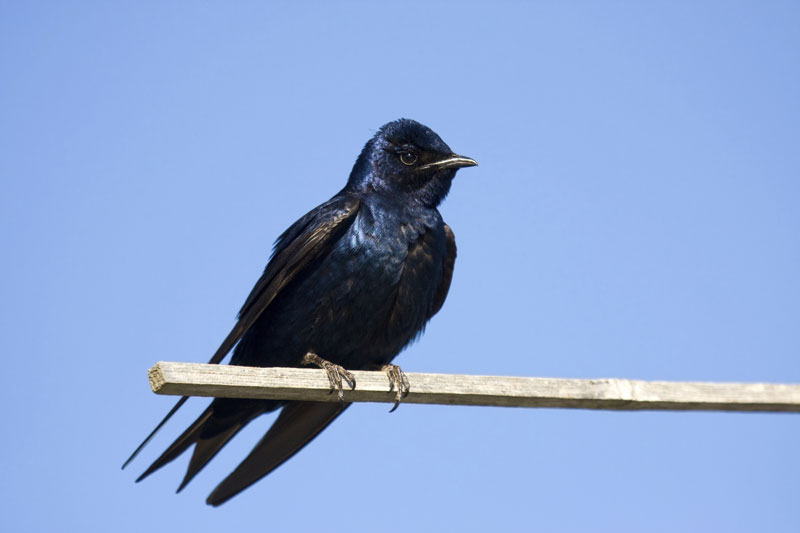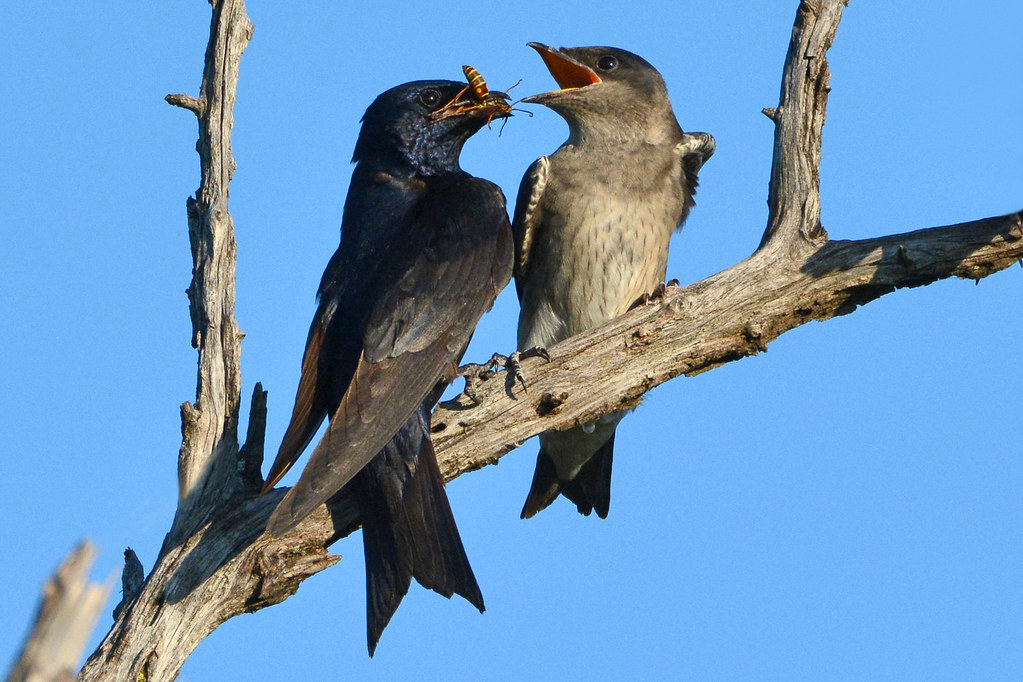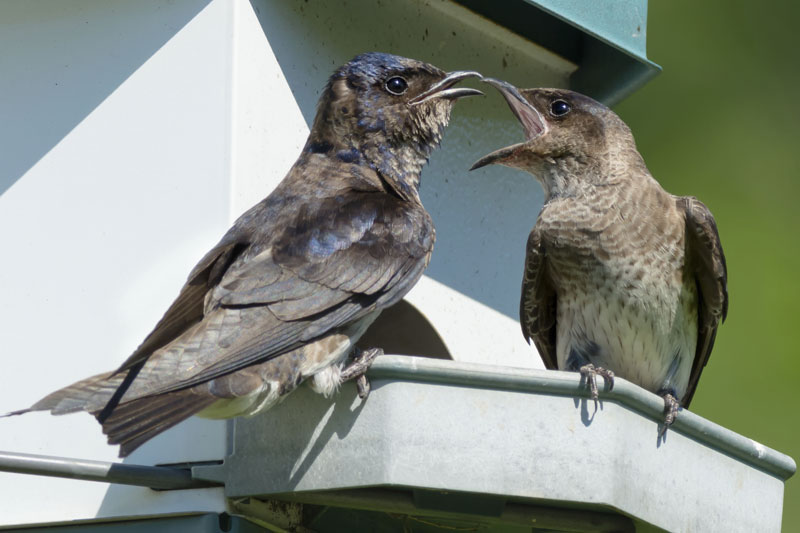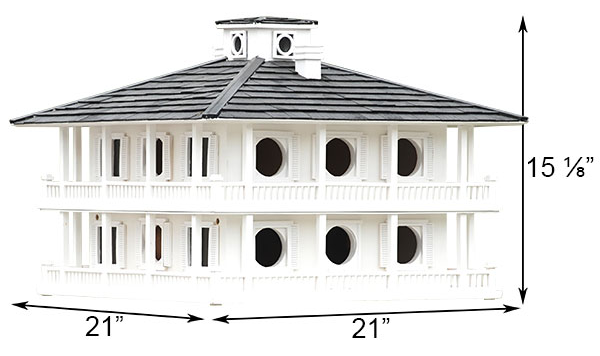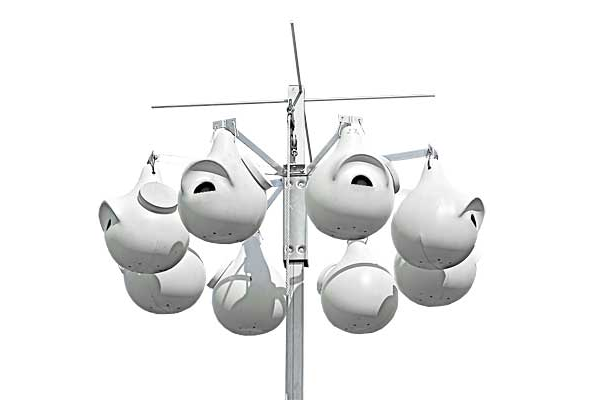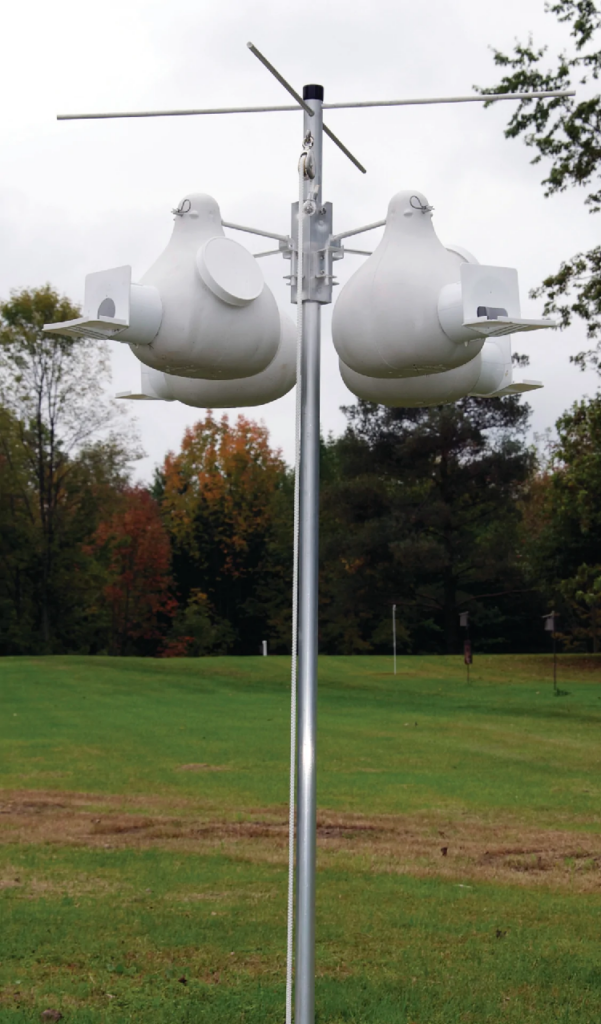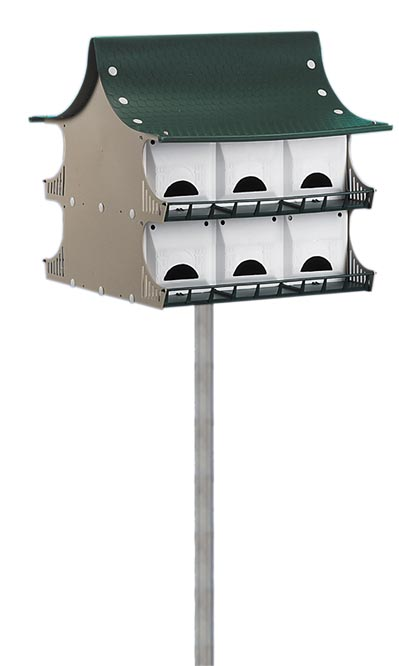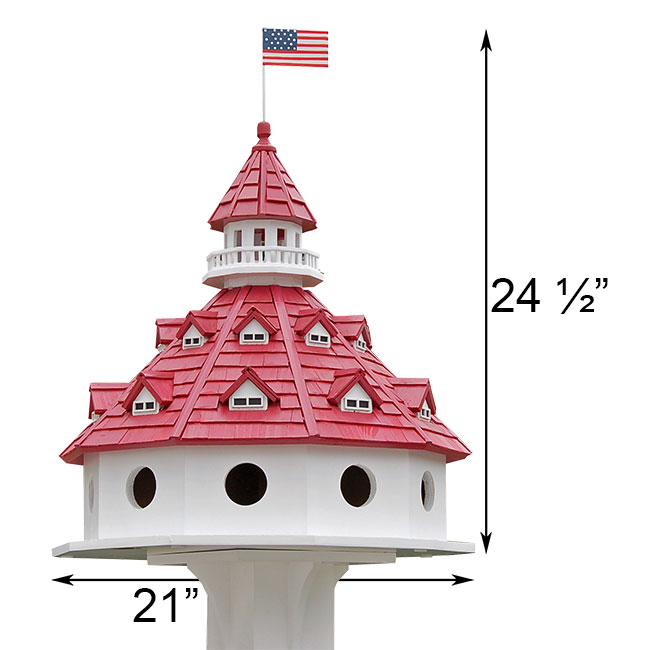- Amethyst-throated Mountain-Gem Guide (Lampornis amethystinus) - November 24, 2022
- Best Martin Bird House Guide - November 14, 2022
- Best Millet Bird Seed Guide - November 9, 2022
Purple Martins are fascinating birds for so many reasons. One of which is their colony nesting behavior. This behavior makes it great fun to provide Purple Martins in your area with suitable housing. Once you learn more about Purple Martin birdhouses, you’ll easily see why.
Throughout eastern North America, Purple Martins thrive in towns, across farms, and near the water along semi-open country. The Purple Martin can be easy for bird lovers to overlook when they have not given the bird the proper observation time it deserves. If you’ve not been acquainted with the bird, we can easily fix that! Let’s have a quick refresher on the species before we get into the best birdhouses and care tips for Purple Martins.
Purple Martin Identification, Behavior, and Facts
As Purple Martins hunt for food, they can be seen propelling themselves into an effortless glide after several rapid flaps of their wings. The Purple Martin is a broad-chested swallow that has a slightly hooked bill.
A short and forked tail contrasts against lengthy wings. When it comes to size, this bird is smaller than a robin but larger than a tree swallow. They average 7.5 to 7.9 inches in length and 1.6 to 2.1 ounces in weight. Their wingspans are roughly 15.3 to 16.1 inches. It is the largest swallow in North America.
Male Purple Martins are iridescent indigo to navy color. Its wings and tail are deep browns. Females and juveniles are much lighter in appearance. They have dark gray heads, backs, wings, and tails with speckled brown and white bellies. Underparts may be beige in some females. Both males and females have prominently hooked black bills.
It’s uncommon for them to land on the ground other than to collect twigs and plant fibers for their nest. Most foraging and hunting are done in the air, preferably low over the water or very high in the air. The only time the Purple Martin hunts on the ground is during bad weather when insects are hard to find.
Purple Martins are speedy swallows that can fly up to 40 miles per hour. This speed aids them enormously while hunting. They can dive rapidly for bugs or chase them until they make their catch. Their agility in the air also enables the Purple Martin to take a drink of water while soaring over a water source.
Purple Martin Migration and Colonies
Understanding the migratory and nesting patterns of a bird, you plan to attract to your yard is a responsible choice. Doing so means you know when to have their birdhouse cleaned and ready for another nesting season and what to expect as they take up residence in the domicile you’ve so graciously gifted them.
Purple Martin Migration
Purple Martins are long-distance migratory birds. In anticipation of winter across the Eastern United States, this species travels to the southwestern United States, Mexico, and even Central America.
A massive winter roost of a few hundred thousand migrants to 700,000 is formed. As the birds take off to forage, this sudden and enormous movement is detected on the Doppler weather radar as large rings known as roost rings.
When spring is near, the Purple Martins return to their breeding territories, with arrival times happening around mid-January to mid-April or May, depending on their destination. Older birds will arrive at breeding territories first to seek out prime nesting real estate, while younger birds arrive nearly two months later.
The Colony Mentality
Purple Martins socialize and protect each other by forming colonies. Colonies may contain a few hundred nesting pairs! Each colony will perform tasks and live life as a unit most of the time. Colonies hunt for food, visit water sources, and explore their surrounding in smaller groups or as a flock. If a few birds find a food source, calls are used to notify the remainder of the colony about their discovery.
The larger the colony of Purple Martins, the older the group of birds is. Younger colonies can be differentiated by their lower rates of reproductive success. Generally, birds in colonies try to match themselves according to age. Older birds have greater reproductive success simply because they have more experience under their wings and know how to synchronize themselves.
The Origin of Purple Martin Colonies
So it’s obvious at this point that Purple Martins are colonial nesters. But what on earth does this mean? Originally, Purple Martins nested in the large hollowed-out spaces in various trees and sometimes still do in western regions of their range where these nesting sites are more common. Circumstances changed for them over the course of human history with a few significant events.
Around the early 1800s, the Cherokee, Chickasaw, and Choctaw Native Americans began to hollow out gourds and hang them on trees. This was a symbiotic relationship because Purple Martins began to nest in these new cavities and subsequently consumed a large quantity of crop-eating insects that were otherwise a nuisance.
Purple Martins were also able to fend off crows and blackbirds that were harmful to Native Americans’ fields. This was the beginning of the landlord-tenant relationship humans formed with Purple Martins.
Unfortunately, in the 20th century, a wise guy named Eugene Schieffelin thought it would be a wonderful ode to Shakespeare to release as many of the birds mentioned in his works across North America, including the European starling.
Well, Eugene, we really wish you hadn’t. This catastrophic event and unprecedented deforestation led to Purple Martins landing their name on the Blue List. The Blue List was created to indicate serious issues with a species or ecosystem.
As conservation efforts increased, providing colony-style houses for Purple Martins became extremely common. Thus the human landlord and Purple Martin relationship became strong, and the species is now classified as being of Least Concern by the IUCN.
The species has become reliant on these nesting structures, with many males returning to the same birdhouse each breeding season.
A Call To Action: Millenials and Martins!
Are you a millennial bird watcher just like me? A study conducted in 2019 discovered that 90% of people who provide Purple Martin birdhouses are 50 years or older. The study entitled “Resisting Extinction: Purple Matins, Death, and the Future” also found younger individuals lacked enthusiasm or the resources (i.e., a yard, am I right?) when it came to providing Purple Martins with housing. This breaks my heart.
I do not want to watch these marvelously tenacious birds suffer yet again, and neither should you! So, if you’re reading through this guide with the intention of giving your mom, dad, or grandparent a Martin birdhouse as a gift, buy one for yourself too!
The Top 5 Best Purple Martin Birdhouses
Since humans created this dependency for nesting sites among Purple Martins, the least we can do is continue to provide suitable housing for them. If you opt to become a bird landlord, you’ll need to be vigilant and deter European starlings and house sparrows from taking over these highly desired nesting sites.
Birdhouse Styles
When selecting a birdhouse for these adorable colony nesters, there are two main types: gourds and apartments.
Gourds are fruits from flowering plants in the family Cucurbitaceae. They have hard skin, similar to that of a pumpkin. Once hollowed and dried, gourds make optimal homes for Purple Martins. Many of these small structures are hung in clusters from tall racks that can accommodate 8 to 12 gourds. Plastic man-made gourds offer durability and special features that natural gourds do not, but it really comes down to personal preference.
The other type of Purple Martin housing is an apartment or condominium-style birdhouse. These birdhouses are single structures that have many compartments or “rooms.” The number of rooms ranges from 12 to 18, and multiple houses can be added. A 16-room apartment can house 16 mating pairs at once! That’s a full house, for sure. Martin houses come in many different styles, from castles to barns and mansions; you can add a bit of personal flair to your yard.
Apartments and gourds can be mixed and matched within the same area to provide variety both for you and the birds. Each type of birdhouse structure requires its own maintenance, cleaning, and protection requirements. Whichever you choose, you must commit to the duty of following these guidelines to ensure their safety and success.
To start your journey as a Purple Martin landlord, let’s look a the best purple martin birdhouses available.
1. Home Bazaar Purple Martin 16 Room Clubhouse
This elegant handcrafted birdhouse is worthy of being the new home for up to 16 mating pairs. This southern-style mansion has actual roof shingles, faux shutters, and a cupola to provide ventilation.
BestNest recommends refinishing this birdhouse with UV-rated polyurethane paint if you wish to maintain this classic finish year after year.
When repainting a birdhouse, start by sanding away any peeling or flaking paint. Flaking paint can get in the eyes of small birds, or they may accidentally eat a paint chip. Wash the birdhouse to remove dust and let it dry thoroughly before applying a new coat. Add as many coats as necessary to ensure weather resistance, but never paint over drainage holes, ventilation holes, or the inside ring of an entrance hole.
You’ll need to purchase the mounting post and mounting bracket to hang this lovely birdhouse, but this will be required for every Purple Martin apartment-style house.
Additional Components Needed (not included):
2. Troyer’s Birds’ Paradise Horizontal Gourd Rack with 8 SuperGourds
A gourd system is an expensive investment, but the quality of this particular one will last the test of time. If you’re going to go all out, this is the kit for you.
This system has eight high-quality gourds and everything else you need to start housing Purple Martins immediately. The tall aluminum pole is easily inserted deep into the soil for stability. Polyester rope is included to operate the pulley feature, which allows for quick lowering and raising of the pole.
The SuperGourds are as intense as they sound. They have an extremely practical design and are constructed from high-density polyethylene that will hold strong for many seasons. The crescent-shaped entry holes are starling-resistant, so you can rest easy and know your Martins are safe. Porch assemblies may be added to the gourds for additional perching, and plastic screw caps on the side make for convenient nest checks and cleaning.
This kit comes with the following components:
- 8 Troyer’s SuperGourds with Crescent Entries and Perches
- One 14-foot pole
- One 48-inch ground socket
- Two 48-inch perching rods
- 4 U-shaped gourd arms
- Polyester rope
- Hardware
3. Ravenox 4 Gourd Rack (Gourds Not Included)
If you want to test the waters before committing to becoming a big-time landlord, the Ravenox Gourd Rack system introduces responsibility in baby steps. This is a wonderful budget-friendly and beginner option. You will need to purchase gourds to accompany it, which means you can select some that appeal to your needs and budget.
This system features a pulley system for lowering and raising the pole, along with nylon glide tabs that protect it from squeaking. Other included components are:
- Two-piece 12.5-foot pole
- Heavy-duty ground stake
- Top perch rods
- Four aluminum, horizontal gourd arms
- Hitch pins
- Rope winder
- Hub with attached eye-bolt
- Rope and pulley
4. S&K 12 Room Purple Martin House Package
If you are set on apartment-style housing and are nervous you might forget something; then this all-inclusive kit is the right choice. You can’t go wrong, and the price is right.
BestNest sells the Stokes Purple Martin book separately, so if you’ve got your eye on a different system, I recommend adding this helpful guide to your cart. The book includes everything you need to know about attracting Martins, colony care, and birdhouse maintenance. This kit also includes two decoys, which aim to catch the eye of curious Martins and encourage them to move in.
The included components are:
- One 12 Room Purple Martin House
- One 15-foot Telescoping Aluminum Pole & Ground Socket
- Two Heath Deluxe Purple Martin Decoys
- One Stokes Purple Martin Book
5. Home Bazaar Hotel Del Coronado 10-Room House
Hotel Del Coronado in San Diego, California, is an iconic beach resort built in 1888. It is one of the last surviving wooden Victorian beach resorts in the world, which is reason enough for this charming replica. If you already know the drill and are simply looking for a quaint new addition to your landlord portfolio, this 10-room Martin house is ideal.
The eye-catching maroon roof features an adorable cupola that offers ventilation while adding flair. The birdhouse has holes under each apartment for drainage and end-of-season cleaning.
Additional Components Needed (not included):
If you do not already have one, you’ll need to purchase a post and mount to adhere to this birdhouse.
Purple Martin Birdhouse Placement Guidelines
After investing time and money into your birding hobby, it’s important that all your efforts are successful. Learning where to place your new Martin house and how to take care of it are essential pieces of the puzzle, just as much as the birdhouse is.
Habitat and Location
Purple Martin houses need to be placed in areas with ample open spaces that are 40 to sixty feet from trees, houses, or structures. Ideally, the birdhouse is also within 100 feet of humans, whether that be a house or someplace with human activity.
These two things ensure that your Purple Martin colony is protected as much as possible from invasive birds like starlings and house sparrows. It also deters other predators like owls, snakes, and raccoons.
Martins will almost certainly decide to move into the birdhouse if it is also placed near a permanent water source.
The mounting post should be 12 to 20 feet tall if you choose to install an apartment. The more open the area, the shorter the post can be.
Purple Martin Colony Care and Maintenance Tips
Tip One: Remove old nests before the return of migrating Martins. Birds should be gone by September and return around February. Remove old nesting materials and clean the interior of houses and gourds with a weak bleach solution. Easily mix the solution at home by combining five parts bleach with 95 parts water. After wiping out the interior, rinse it with plain water.
Tip Two: Check that all compartments have adequate drainage and ventilation before installation. For proper insulation, wooden birdhouses need to have walls that are 3/4 inch thick.
Tip Three: Perches give predators easy access. Most houses come with option perches, just go ahead and toss them aside.
Tip Four: Plug entrances during winter to deter starlings and sparrows from roosting in the boxes or gourds. These can be removed early before Purple Martins’ arrival in your area. Males return to nesting territories anywhere from January to April or May, depending on your location.
Tip Five: Telescoping poles are prime climbing opportunities for predators. By adding baffles, you stop predators in their tracks. Baffles can be purchased, or DIY’d. Other deterrents are products like Tanglefoot can be smeared on poles to discourage climbers.
Tip Six: Repaint birdhouses and grounds regularly to ensure they are protected against UV rays and weather. Use a polyurethane-rated paint and always stick with white. Other colors will attract predators and can overheat in direct sunlight.
Tip Seven: If you opt for the gourd and rack system, ensuring the pulley function is operational is very important. Raising and lowering the rack is essential to check nests for nesting starlings and house sparrows. You will have to evict these birds by removing their nests. Gourds and houses with predator guards are ideal to limit or completely avoid this issue.
How To Attract Purple Martins To Your Yard
Not everyone needs to purchase a Purple Martin birdhouse to enjoy these beautiful swallows. Instead, you can promote their activity in your yard by attracting them in a few simple ways. If you do have Purple Martin housing, following these guidelines will ensure you have a happy colony that returns each breeding season.
Food and Water
Purple Martins are never seen enjoying birdseed or dried insects at feeders. Instead, they forage for every. single. meal. Purple Martins are insectivorous, and if you promote insects in your backyard, the Purple Martins will follow.
Insects favored by Purple Martins include beetles, crickets, dragonflies, butterflies, leafhoppers, moths, wasps, bees, spiders, cicadas, termites, and mayflies.
Many people try to attract Purple Martins with the hope that there will be fewer mosquitos in the area. The only problem is that Purple Martins feed at heights of 160 to 500 feet, and not many mosquitos ever venture that high. We all wish it were true, but even Cornell Lab of Ornithology looked inside the bellies of nearly 200 Purple Martins, and no mosquitos were found. Bummer!
These birds will pick up pieces of gravel to add grit to their diet. You can help by placing eggshells out. This gives Purple Martins the grit that they need to digest insects effectively. These birds will accept egg shells readily. Scatter them around the yard or place them on a tray feeder near their nesting colony. If you have fruit that is going to waste, put it out to attract insects.
Keeping a tamed area of open lawn acts as a hunting ground for Purple Martins to search for unsuspecting insects. Insects prefer longer grass, so grass should stay a little longer than you might mow it for a garden party. Never use insecticides or pesticides. This applies across the board for all birds and animals.
Purple Martins cannot go longer than one day without food. If it reaches three days without food, there is not a lot you can do as it is too weak to accept food. Promoting healthy insect populations gives Martins in your area a buffet of options. The reasons a Purple Martin may starve to death depend completely on the weather conditions.
Add a moving water feature or bird bath to your yard. Many birds, including swallows, prefer moving water. Birds will hear the bubbling water and see the sparkles as the sunlight catches the movement.
Nesting Sites
Assuming you’re planning on installing a Purple Martin birdhouse, you don’t need to worry about shelter. If you’re unsure whether you have Purple Martins in your area, you can start by offering natural nesting sites. Dead trees are optimal nesting sites, and there can be quite the competition for them. If it is safe, always leave dead trees and snags. So many birds rely on these trees to survive, and we often remove them immediately just because they may be unsightly.
Purple Martin Breeding and Nesting
Purple Martins are a socially monogamous species, but this does not disrupt their ability to form a seasonal breeding pair. I say seasonal because pairs rarely reunite, as we’ve seen in other species of birds.
Males arrive at the breeding grounds first to select two adequate nesting sites. The female arrived a month later to make the final decision. Once she has, the male will defend this territory aggressively against other males.
If a male has not found a mate, he spends his days hoping to attract one by performing an acrobatic courtship display. This display involves flying in and out of his nesting cavity while singing a lovely song. While the males believe that this really works, researchers found that females care more about the nesting territory than the courtship display.
Nest building occurs shortly after a pair is formed and around one month before egg laying. Nests are constructed from a collection of grass, sticks, mud, feathers, and leaves. The pair separates duties to be most efficient. While the female constructs the nest, the works hard gathering materials and defending their nesting site.
From May to June, breeding is the primary focus of Purple Martins. The female lays between 4 to 6 eggs. Eggs are oval, white, and smooth. The female incubates these for two weeks or a few days longer. After hatching, both the male and female feed the chicks. Chicks fledge around days 26 to 31. Young stick together through the fledging process, staying in groups as they fly. They return to the nest to sleep and continue this behavior for 7 to 10 days before separating to fend for themselves.
Purple Martin Predators
If you haven’t caught on already, Purple Martins spend the breeding season in constant battle with predators. It is pertinent to understand who preys on them so you can assist in keeping the colony safe.
Common predators of Purple Martins are owls and snakes. Each of these creatures shows no preference between juveniles and adults and only aims to grab whoever is most conveniently located.
Owls attack Martins by grabbing and shaking the nest. As you can imagine, this feels like being put through the spin cycle on a washing machine but probably more terrifying. As the birds attempt to escape through the entrance, the owl clutches onto them with deadly talons.
Predator guards that deter owls involve placing a curved rod over nest entrances. Other owl deterrents are wind chimes and noisemakers such as alarms, horns, and whistles. Placing decoy owls in your yard may also prove effective. Check out products like these Gourd Rack Owl Guards by the Purple Martin Conservation Association.
These types of guards also work against other large birds like hawks and crows. The curved aluminum rods make it impossible for birds to cling to the entrance of the nesting site while providing safe perching space for your Purple Martins. Always verify that your selected predator guard is compatible with the gourd system you purchased.
Snakes and raccoons annoyingly scale poles to reach birdhouses and gourds, specifically for eggs and young. Non-poisonous snakes like Rat snakes are typically the offenders, so remain calm and always use a resource to confirm the snake species before interfering. Adding baffles to the poles will drastically decrease a snake or raccoon’s chances of invading a nest.
Squirrels…does it ever end? From scaring away birds at the feeder to interfering with nests, these little rascals are a menace to all bird watchers and Purple Martins, too.
Purple Martins work hard to ensure predators do not smell them by eating the fecal sacs of the young. If they are not eaten, they are discarded outside of the nest. Don’t let this hard work go to waste, and invest in predator guards. There are many kinds that can be attached to the entry of the nest or the pole.
The complete list of predators is as follows:
- Cats, domesticated and feral
- Blue Herons
- Blue Jays
- Magpies
- Crows
- Gulls
- Rat snakes
- Snakes
- Raccoons
- Squirrels
- Hawks
- Owls
Purple Martin Predator Response
Taking matters into their own hands or wings rather, a ringing of “zweet, zweet, zweet” can be heard to alert the colony. After ringing the warning bell, the birds will dive at intruders. This is not done in any kind of synchronicity, but there is strength in numbers. Only the owners of the targeted nest make the attack, while the rest of the colony or those present all gather to distract and confuse the predator.
Since the large colony works together to detect predators, they experience less predation than species such as bluebirds.
Purple Martin Lifespan
Purple Martins live at the will of the weather. After more than three days of rough conditions, the quantity of available insects decreases significantly. Predators and parasites must also be bypassed to live long, healthy lives. If these factors can be avoided, Purple Martins can live up to thirteen years of age.
FAQs
Answer: Purple Martins are cavity nesters that have relied on the human supply of nesting sites since the 1800s. They are partial gourds and colony-style birdhouses, also known as apartments or condominiums. When choosing a birdhouse, ensure that each compartment or apartment is 7 inches wide by 12 inches deep. This gives the nesting pair plenty of space and provides greater protection against predators and inclement weather.
Answer: A wide and open area is ideal for gourd racks and birdhouse posts to be installed. The area should be at least 40 feet to 120 feet from human housing or activity and 40 feet to 60 feet away from any trees or structures.
Answer: Purple Martins spend their days foraging for insects and looking for suitable nesting sites. Open up your outdoor space and encourage insect activity. Do not use pesticides; keep the grass medium-length to keep insects happy. Providing nesting sides in the form of dead trees, snags, or man-made structures such as birdhouses and gourd racks are straightforward ways to let the Martins know you are providing a safe space. Deter other bird species by placing feeders elsewhere on your property or removing them completely.
Answer: Purple Martins will return to nesting territories each year if you create a suitable enough environment for them. Males return to breeding grounds first and can return as early as January, depending on your location. Placing nest boxes out in late March is a safe call in most areas. This creates less chance that starlings and house sparrows will roost in the box, which leads to eviction and more cleaning for you.
References
- The impact of Starlings on Purple Martin populations in unmanaged colonies
- Announcing – The Blue List: an “early warning system” for birds
- Resisting Extinction: Purple Martins, Death, and the Future
Looking for more interesting readings? Check out:


